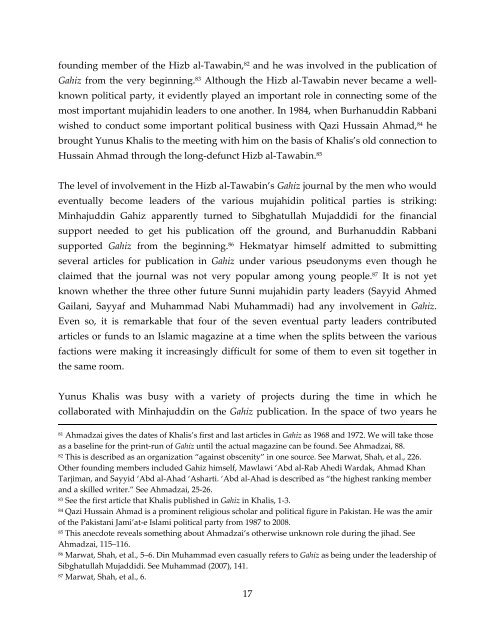Usama bin Ladin’s “Father Sheikh”:
Usama bin Ladin’s “Father Sheikh”:
Usama bin Ladin’s “Father Sheikh”:
Create successful ePaper yourself
Turn your PDF publications into a flip-book with our unique Google optimized e-Paper software.
founding member of the Hizb al‐Tawa<strong>bin</strong>, 82 and he was involved in the publication of<br />
Gahiz from the very beginning. 83 Although the Hizb al‐Tawa<strong>bin</strong> never became a well‐<br />
known political party, it evidently played an important role in connecting some of the<br />
most important mujahidin leaders to one another. In 1984, when Burhanuddin Rabbani<br />
wished to conduct some important political business with Qazi Hussain Ahmad, 84 he<br />
brought Yunus Khalis to the meeting with him on the basis of Khalis’s old connection to<br />
Hussain Ahmad through the long‐defunct Hizb al‐Tawa<strong>bin</strong>. 85<br />
The level of involvement in the Hizb al‐Tawa<strong>bin</strong>’s Gahiz journal by the men who would<br />
eventually become leaders of the various mujahidin political parties is striking:<br />
Minhajuddin Gahiz apparently turned to Sibghatullah Mujaddidi for the financial<br />
support needed to get his publication off the ground, and Burhanuddin Rabbani<br />
supported Gahiz from the beginning. 86 Hekmatyar himself admitted to submitting<br />
several articles for publication in Gahiz under various pseudonyms even though he<br />
claimed that the journal was not very popular among young people. 87 It is not yet<br />
known whether the three other future Sunni mujahidin party leaders (Sayyid Ahmed<br />
Gailani, Sayyaf and Muhammad Nabi Muhammadi) had any involvement in Gahiz.<br />
Even so, it is remarkable that four of the seven eventual party leaders contributed<br />
articles or funds to an Islamic magazine at a time when the splits between the various<br />
factions were making it increasingly difficult for some of them to even sit together in<br />
the same room.<br />
Yunus Khalis was busy with a variety of projects during the time in which he<br />
collaborated with Minhajuddin on the Gahiz publication. In the space of two years he<br />
81 Ahmadzai gives the dates of Khalis’s first and last articles in Gahiz as 1968 and 1972. We will take those<br />
as a baseline for the print‐run of Gahiz until the actual magazine can be found. See Ahmadzai, 88.<br />
82 This is described as an organization “against obscenity” in one source. See Marwat, Shah, et al., 226.<br />
Other founding members included Gahiz himself, Mawlawi ‘Abd al‐Rab Ahedi Wardak, Ahmad Khan<br />
Tarjiman, and Sayyid ‘Abd al‐Ahad ‘Asharti. ‘Abd al‐Ahad is described as “the highest ranking member<br />
and a skilled writer.” See Ahmadzai, 25‐26.<br />
83 See the first article that Khalis published in Gahiz in Khalis, 1‐3.<br />
84 Qazi Hussain Ahmad is a prominent religious scholar and political figure in Pakistan. He was the amir<br />
of the Pakistani Jami’at‐e Islami political party from 1987 to 2008.<br />
85 This anecdote reveals something about Ahmadzai’s otherwise unknown role during the jihad. See<br />
Ahmadzai, 115–116.<br />
86 Marwat, Shah, et al., 5–6. Din Muhammad even casually refers to Gahiz as being under the leadership of<br />
Sibghatullah Mujaddidi. See Muhammad (2007), 141.<br />
87 Marwat, Shah, et al., 6.<br />
17


